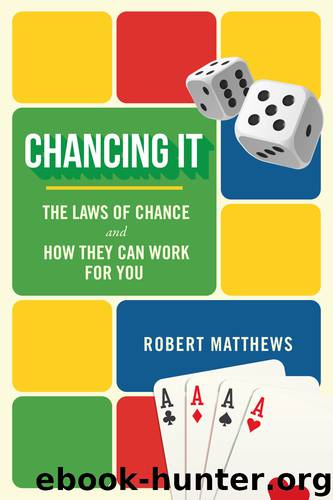Chancing It by Robert Matthews

Author:Robert Matthews
Language: eng
Format: epub
Publisher: Skyhorse Publishing
Published: 2017-08-22T04:00:00+00:00
But as Bayes showed in his completely uncontroversial results concerning conditional probabilities, flipping them around like this is a very dangerous thing do. As we saw with the example in the box on p141, with simple probability questions it leads to results that are just flat wrong – such as the probability that a card is a diamond, given it’s red (50 per cent probability), is equal to the probability a card is red, given it’s a diamond (which is 100 per cent). When used to turn evidence into insights, however, carelessly flipping conditional probabilities around like this is a recipe for disaster. That’s because it commits the logical fallacy of first assuming something is true to reach a deduction, and then using the deduction to test the assumption.
Bayes’s Theorem shows that the only way we can flip conditional probabilities around is by bringing in extra information. And in the case of drawing inferences about our beliefs from data, that means including some prior probability that our belief is correct. That, in turn, means we must face up to the Problem of Priors. As we’ve seen, it’s not always a problem: sometimes there’s an obvious source of such prior insight – such as past research. But often there isn’t, and we must face the fact that drawing insights from data can involve subjective guesswork. Crucially, however, Bayes’s Theorem shows that – as the US Coast Guard demonstrated – as evidence accumulates, whatever initial guesses were used tends to become ever less important, and the evidence ‘speaks for itself’.7
As the frequentist methods became ever more popular, some statisticians repeatedly tried to warn of the dangers of sweeping all this under the carpet. They were more or less completely ignored for decades. Even today, many researchers continue to use frequentist methods to extract insights from data. As a result, countless claims in fields ranging from economics and psychology to medicine and physics are at best questionable, and quite possibly flat wrong. Evidence for this is now starting to rear its head, as researchers struggle to replicate ‘discoveries’ based on the flawed logic of frequentism. We’ll look at this deeply disturbing issue later, but perhaps the most shocking aspect of it is that frequentism’s flaws have been tolerated for so long. That’s changing. What are now known as Bayesian methods are increasingly being put to use by researchers in a host of fields. Part of the reason is their power. Until recently, the full armamentarium of Bayesian tools wasn’t available to researchers who – like Bayes himself – found themselves facing problems doing the sums needed to apply them to real-life problems. That’s now been solved by the emergence of cheap, plentiful computing power, which allows Bayesian methods to be used in very sophisticated problems involving lots of competing theories.
At the same time, researchers are becoming increasingly aware of the many virtues of the Reverend Bayes’s miraculous formula. And as we’ll see shortly, one doesn’t even need to plug in any numbers to benefit from them.
Download
This site does not store any files on its server. We only index and link to content provided by other sites. Please contact the content providers to delete copyright contents if any and email us, we'll remove relevant links or contents immediately.
Modelling of Convective Heat and Mass Transfer in Rotating Flows by Igor V. Shevchuk(6226)
Weapons of Math Destruction by Cathy O'Neil(5833)
Factfulness: Ten Reasons We're Wrong About the World – and Why Things Are Better Than You Think by Hans Rosling(4489)
Descartes' Error by Antonio Damasio(3166)
A Mind For Numbers: How to Excel at Math and Science (Even If You Flunked Algebra) by Barbara Oakley(3104)
Factfulness_Ten Reasons We're Wrong About the World_and Why Things Are Better Than You Think by Hans Rosling(3046)
TCP IP by Todd Lammle(3013)
Applied Predictive Modeling by Max Kuhn & Kjell Johnson(2908)
Fooled by Randomness: The Hidden Role of Chance in Life and in the Markets by Nassim Nicholas Taleb(2861)
The Tyranny of Metrics by Jerry Z. Muller(2849)
The Book of Numbers by Peter Bentley(2779)
The Great Unknown by Marcus du Sautoy(2538)
Once Upon an Algorithm by Martin Erwig(2474)
Easy Algebra Step-by-Step by Sandra Luna McCune(2469)
Lady Luck by Kristen Ashley(2416)
Practical Guide To Principal Component Methods in R (Multivariate Analysis Book 2) by Alboukadel Kassambara(2380)
Police Exams Prep 2018-2019 by Kaplan Test Prep(2358)
All Things Reconsidered by Bill Thompson III(2261)
Linear Time-Invariant Systems, Behaviors and Modules by Ulrich Oberst & Martin Scheicher & Ingrid Scheicher(2233)
